Research on a CMOS-MEMS Infrared Sensor with Reduced Graphene Oxide
Abstract
:1. Introduction
2. Design and Fabrication
2.1. Design and Fabrication
2.2. Post-Processing
3. Characteristics Measurement and Analysis
3.1. Thermal Radiation Absorption Characteristic
3.1.1. Measurement of Thermal Radiation Absorption
3.1.2. Analysis of Thermal Radiation Absorption
3.2. Thermal Radiation Emission Characteristic
3.2.1. Measurement of Thermal Radiation Emission
3.2.2. Analysis of the Thermal Radiation Emission
3.3. Measurement and Analysis of the Sensor
3.3.1. Analysis of Responsivity
3.3.2. Measurement and Analysis of Frequency Response and Thermal Time Constant
3.3.3. Measurement of Noise
3.3.4. Analysis of SNR
3.3.5. Figure of Merit of the Sensor
3.3.6. Measurement and Analysis of Incident Angle of IR Radiation
4. Conclusions
Author Contributions
Funding
Acknowledgments
Conflicts of Interest
References
- Fu, C.J.; Zhang, Z.M. Nanoscale radiation heat transfer for silicon at different doping levels. Int. J. Heat Mass Transf. 2006, 49, 1703–1718. [Google Scholar] [CrossRef]
- Lim, M.; Lee, S.S.; Lee, B.J. Near-field thermal radiation between graphene-covered doped silicon plates. Opt. Express 2013, 21, 22173–22185. [Google Scholar] [CrossRef] [PubMed]
- Basu, S.; Lee, B.J.; Zhang, Z.M. Near-field radiation calculated with an improved dielectric function model for doped silicon. J. Heat Transf. 2010, 132, 023302–023309. [Google Scholar] [CrossRef]
- Li, N.; Yuan, H.; Tao, J.; Cheam, D.D.; Xu, L.; Zhao, D.; Cai, H.; Singh, N. A Monolithically Integrated CMOS-MEMS Infrared Emitter with Graphene Oxide for Emission Enhancement. In Proceedings of the Conference on Lasers and Electro-Optics (CLEO), San Jose, CA, USA, 5–10 May 2019. [Google Scholar]
- Hsu, A.; Herring, P.; Gabor, N.; Ha, S.; Shin, Y.C.; Song, Y.; Chin, M.; Dubey, M.; Chandrakasan, A.P.; Kong, J.; et al. Graphene-based thermopile for thermal imaging applications. Nano Lett. 2015, 15, 7211–7216. [Google Scholar] [CrossRef] [PubMed]
- Qu, Z.; Nedeljkovic, M.; Solerpenades, J.; Khokhar, A.Z.; Cao, W.; Wu, Y.; Osman, A.; Qi, Y.; Aspiotis, N.; Morgan, K.; et al. Waveguide integrated graphene mid-infrared photodetector. In Proceedings of the SPIE 10537, Silicon Photonics XIII, San Francisco, CA, USA, 22 February 2018. [Google Scholar]
- Sood, A.K.; Egerton, E.J.; Puri, Y.R.; Goldsman, N.; Shao, X.; Akturk, A.; Dhar, N.; Dubey, M.; Wijewarnasuriya, P.S.; Lineberry, B. Design and development of carbon nanotube and graphene based microbolometer for IR imaging applications. In Proceedings of the SPIE 8512, Infrared Sensors, Devices, and Applications II, San Diego, CA, USA, 15 October 2012. [Google Scholar]
- Xu, D.; Wang, Y.; Xiong, B.; Li, T. MEMS-based thermoelectric infrared sensors: A review. Front. Mech. Eng. 2017, 12, 557–566. [Google Scholar] [CrossRef]
- Liddiard, K.C. Thin-film resistance bolometer IR detectors. Infrared Phys. Technol. 1984, 24, 57–64. [Google Scholar] [CrossRef]
- Li, L.; Dobrowolski, J.A.; Sankey, J.D.; Wimperis, J.R. Antireflection coatings for both visible and far-infrared spectral regions. Appl. Opt. 1992, 31, 6150–6156. [Google Scholar] [CrossRef]
- Lehman, J.; Theocharous, E.; Eppeldauer, G.; Pannell, C. Gold-black coatings for freestanding pyroelectric detectors. Meas. Sci. Technol. 2003, 14, 916. [Google Scholar] [CrossRef] [Green Version]
- Acik, M.; Lee, G.; Mattevi, C.; Pirkle, A.; Wallace, R.M.; Chhowalla, M.; Cho, K.; Chabal, Y.J. The role of oxygen during thermal reduction of graphene oxide studied by infrared absorption spectroscopy. J. Phys. Chem. C 2011, 115, 19761–19781. [Google Scholar] [CrossRef]
- Chen, C.N. Fully quantitative characterization of CMOS–MEMS polysilicon/titanium thermopile infrared sensors. Sens. Actuators B Chem. 2012, 161, 892–900. [Google Scholar] [CrossRef]
- Lucas, T.M.; Moiseeva, E.V.; Zhang, G.; Gobin, A.M.; Harnett, C.K. Thermal properties of infrared absorbent gold nanoparticle coatings for MEMS applications. Sens. Actuator A Phys. 2013, 198, 81–86. [Google Scholar] [CrossRef]
- Wolffenbuttel, R.F. MEMS-based optical mini-and microspectrometers for the visible and infrared spectral range. J. Micromech. Microeng. 2005, 15, S145. [Google Scholar] [CrossRef]
- Betts, D.B.; Clarke, F.J.J.; Cox, L.J.; Larkin, J.A. Infrared reflection properties of five types of black coating for radiometric detectors. J. Phys. E Sci. Instrum. 1985, 18, 689–696. [Google Scholar] [CrossRef]
- Schossig, M. Optical Absorption Layers for Infrared Radiation. In Bio and Nano Packaging Techniques for Electron Devices, 1st ed.; Gerlach, G., Wolter, K.J., Eds.; Springer: Berlin/Heidelberg, Germany, 2012; pp. 362–364. [Google Scholar]
- Nelms, N.; Dowson, J. Goldblack coating for thermal infrared detectors. Sens. Actuator A Phys. 2005, 120, 403–407. [Google Scholar] [CrossRef]
- Seo, D.; Park, J.H.; Jung, J.; Park, S.M.; Ryu, S.; Kwak, J.; Song, H. One-dimensional gold nanostructures through directed anisotropic overgrowth from gold decahedrons. J. Phys. Chem. C 2009, 113, 3449–3454. [Google Scholar] [CrossRef]
- Rabieegolgir, H.; Ghandiparsi, S.; Devine, E.P.; Mayet, A.S.; Bartoloperez, C.; Wijewarnasuriya, P.S.; Dhar, N.K.; Islam, M.S. Ultra-thin super absorbing photon trapping materials for high-performance infrared detection. In Proceedings of the SPIE 11002, Infrared Technology and Applications XLV, Baltimore, MD, USA, 7 May 2019. [Google Scholar]
- Vakil, A.; Engheta, N. Transformation optics using graphene. Science 2011, 332, 1291–1294. [Google Scholar] [CrossRef] [Green Version]
- Low, T.; Avouris, P. Graphene plasmonics for terahertz to mid-infrared applications. ACS Nano 2014, 8, 1086–1101. [Google Scholar] [CrossRef] [PubMed] [Green Version]
- Deng, G.; Song, X.; Dereshgi, S.A.; Xu, H.; Aydin, K. Tunable multi-wavelength absorption in mid-IR region based on a hybrid patterned graphene-hBN structure. Opt. Express 2019, 27, 23576–23584. [Google Scholar] [CrossRef]
- Pan, Q.; Zhang, G.; Pan, R.; Zhang, J.; Shuai, Y.; Tan, H. Tunable absorption as multi-wavelength at infrared on graphene/hBN/Al grating structure. Opt. Express 2018, 26, 18230–18237. [Google Scholar] [CrossRef]
- Acik, M.; Lee, G.; Mattevi, C.; Chhowalla, M.; Cho, K.; Chabal, Y.J. Unusual infrared-absorption mechanism in thermally reduced graphene oxide. Nat. Mater. 2010, 9, 840–845. [Google Scholar] [CrossRef]
- Liang, H. Mid-infrared response of reduced graphene oxide and its high-temperature coefficient of resistance. AIP Adv. 2014, 4, 107131. [Google Scholar] [CrossRef] [Green Version]
- Liu, C.H.; Chang, Y.C.; Norris, T.B.; Zhong, Z. Graphene photodetectors with ultra-broadband and high responsivity at room temperature. Nat. Nanotechnol. 2014, 9, 273–278. [Google Scholar] [CrossRef]
- Sahatiya, P.; Puttapati, S.K.; Srikanth, V.V.S.S.; Badhulika, S. Graphene-based wearable temperature sensor and infrared photodetector on a flexible polyimide substrate. Flex. Print. Electron. 2016, 1, 025006. [Google Scholar] [CrossRef]
- Sehrawat, A.P.; Islam, S.S.; Mishra, P.; Ahmad, S. Reduced graphene oxide (rGO) based wideband optical sensor and the role of Temperature, Defect States and Quantum Efficiency. Sci. Rep. 2018, 8, 1–13. [Google Scholar]
- Shen, C.H.; Yeh, Y.Y.; Chen, C.F. A thermopile device with subwavelength structure by CMOS-MEMS technology. Appl. Sci. 2019, 9, 5118. [Google Scholar] [CrossRef] [Green Version]
- Chen, S.J.; Wu, Y.C. Active Thermoelectric Vacuum Sensor Based on Frequency Modulation. Micromachines 2020, 11, 15. [Google Scholar] [CrossRef] [PubMed] [Green Version]
- Tseng, S.H.; Fang, C.L.; Wu, P.C.; Juang, Y.Z.; Lu, S.C. A CMOS MEMS thermal sensor with high frequency output. In Proceedings of the IEEE SENSORS Conference, Lecce, Italy, 26–29 October 2008. [Google Scholar]
- Chen, C.N.; Huang, W.C. A CMOS-MEMS Thermopile with low thermal conductance and a near-perfect emissivity in the 8-14-μm wavelength range. IEEE Electron Device Lett. 2011, 32, 96–98. [Google Scholar] [CrossRef]
- Lin, K.S.; Chen, R. Design and fabrication of CMOS-integrated Thermoelectric IR Microsensors. In Proceedings of the IEEE/LEOS International Conference on Optical MEMs and Nanophotonics, Freiburg, Germany, 11–14 August 2008. [Google Scholar]
- Muley, S.V.; Ravindra, N.M. Emissivity of electronic materials, coatings, and structures. JOM 2014, 66, 616–636. [Google Scholar] [CrossRef]
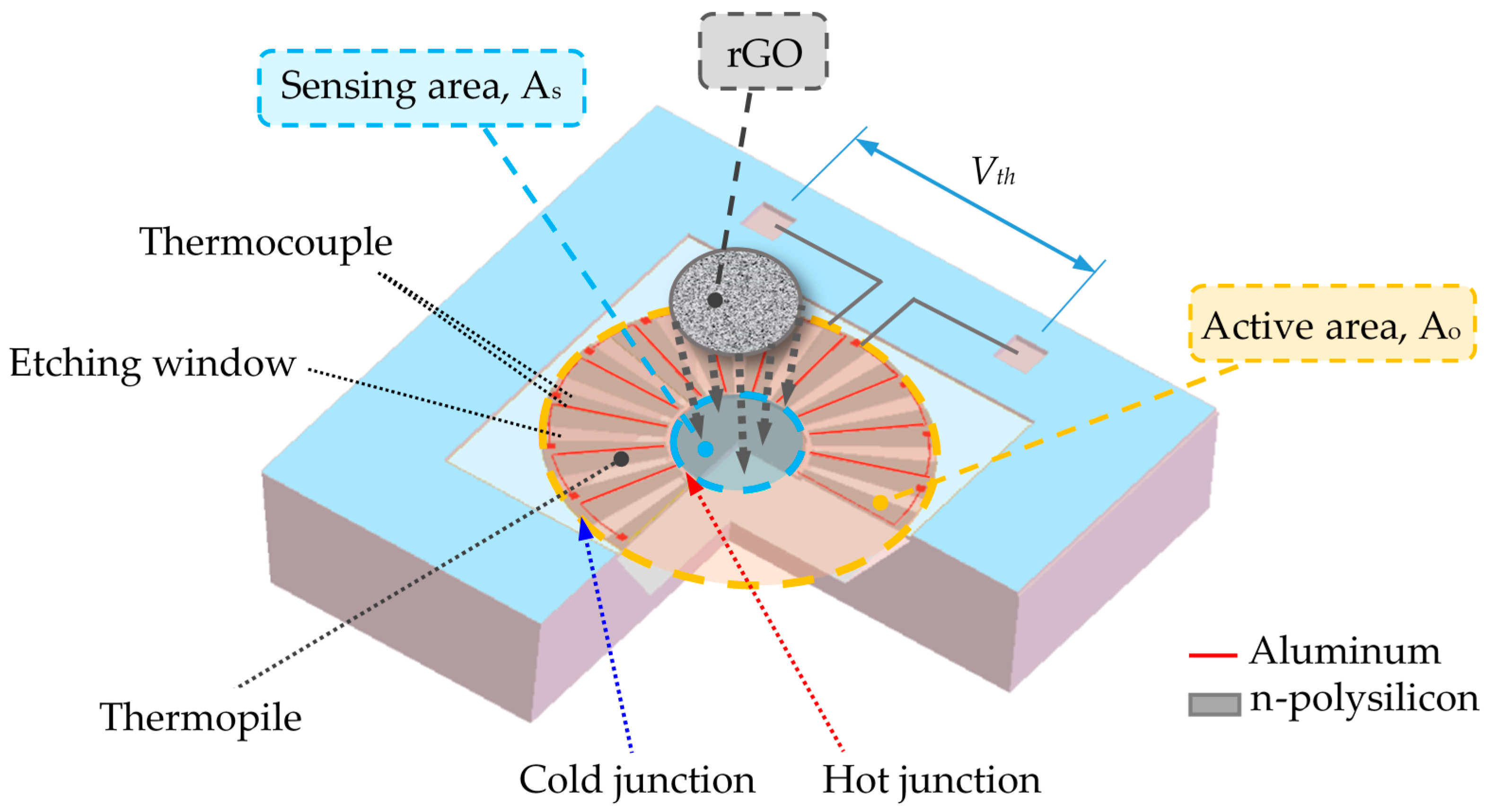

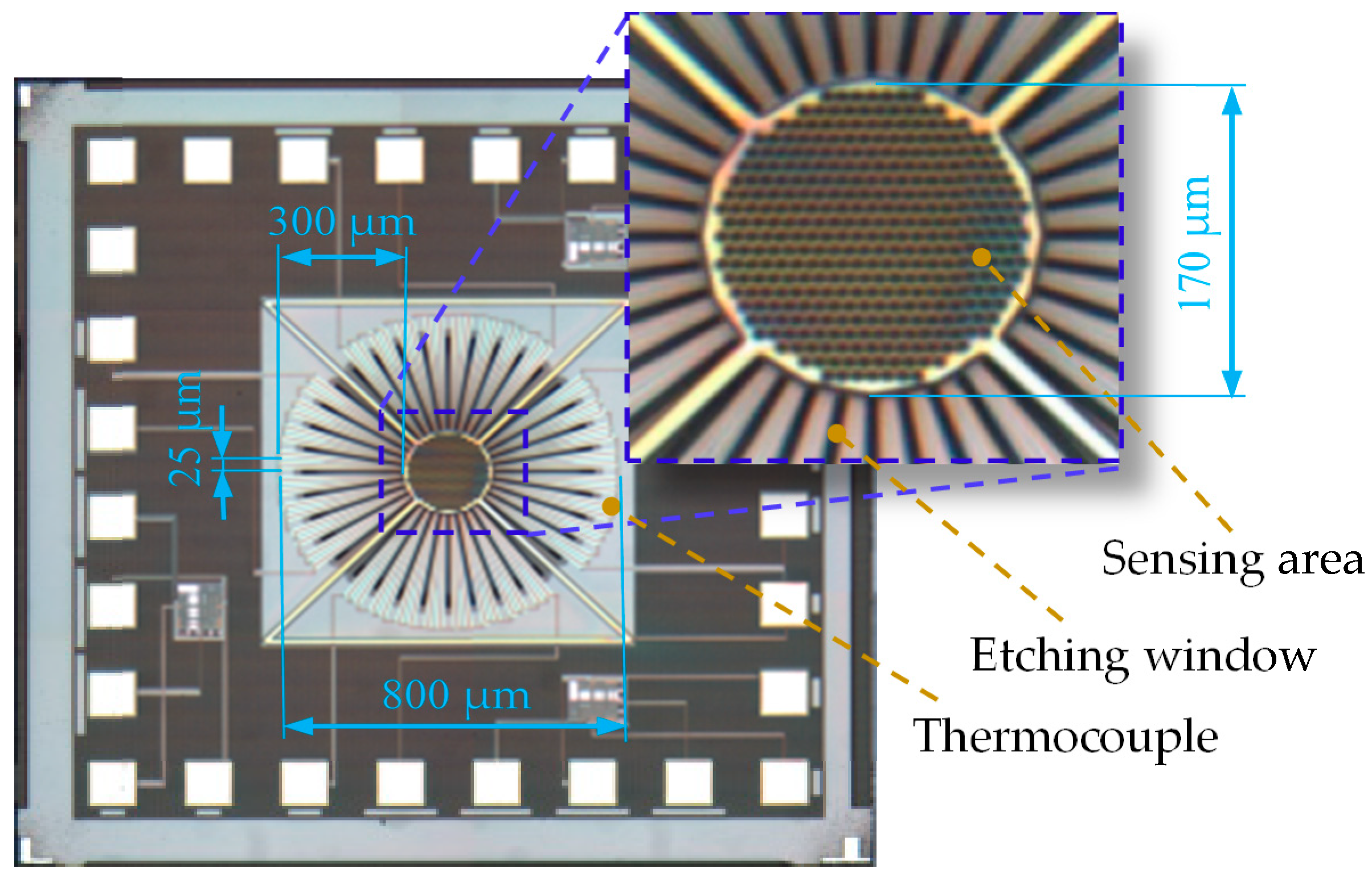



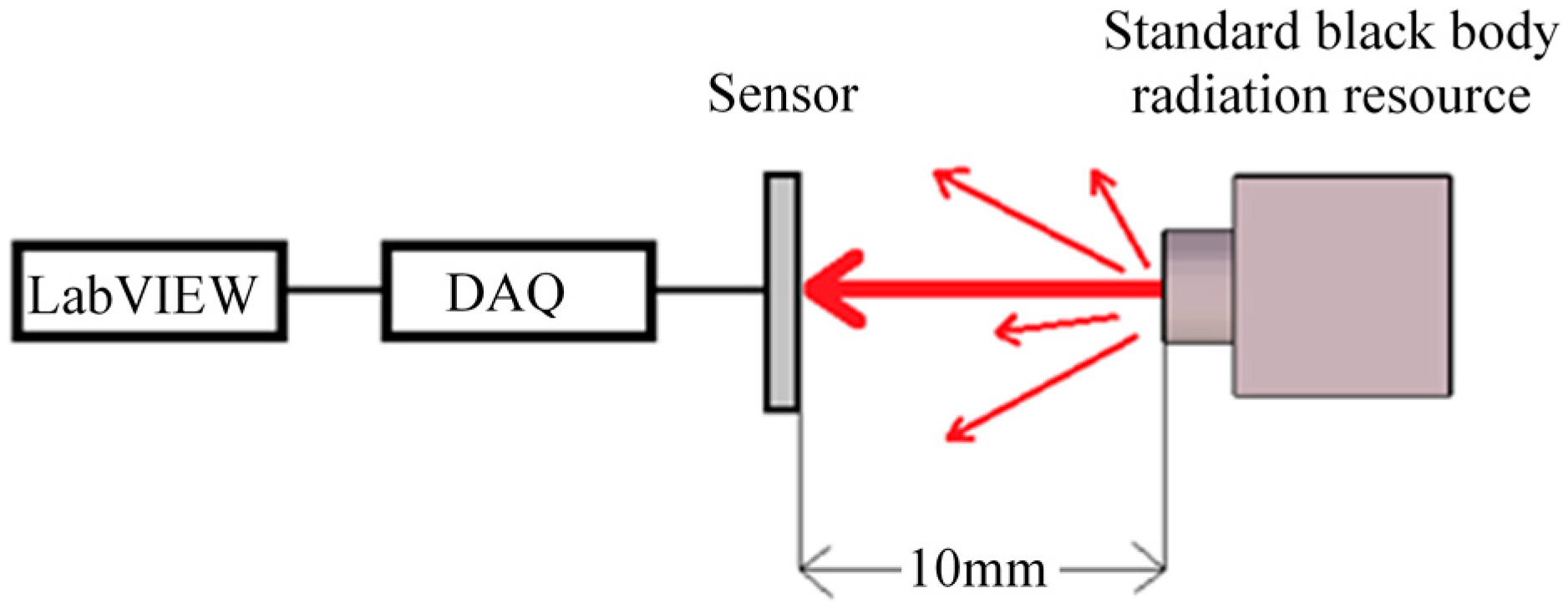
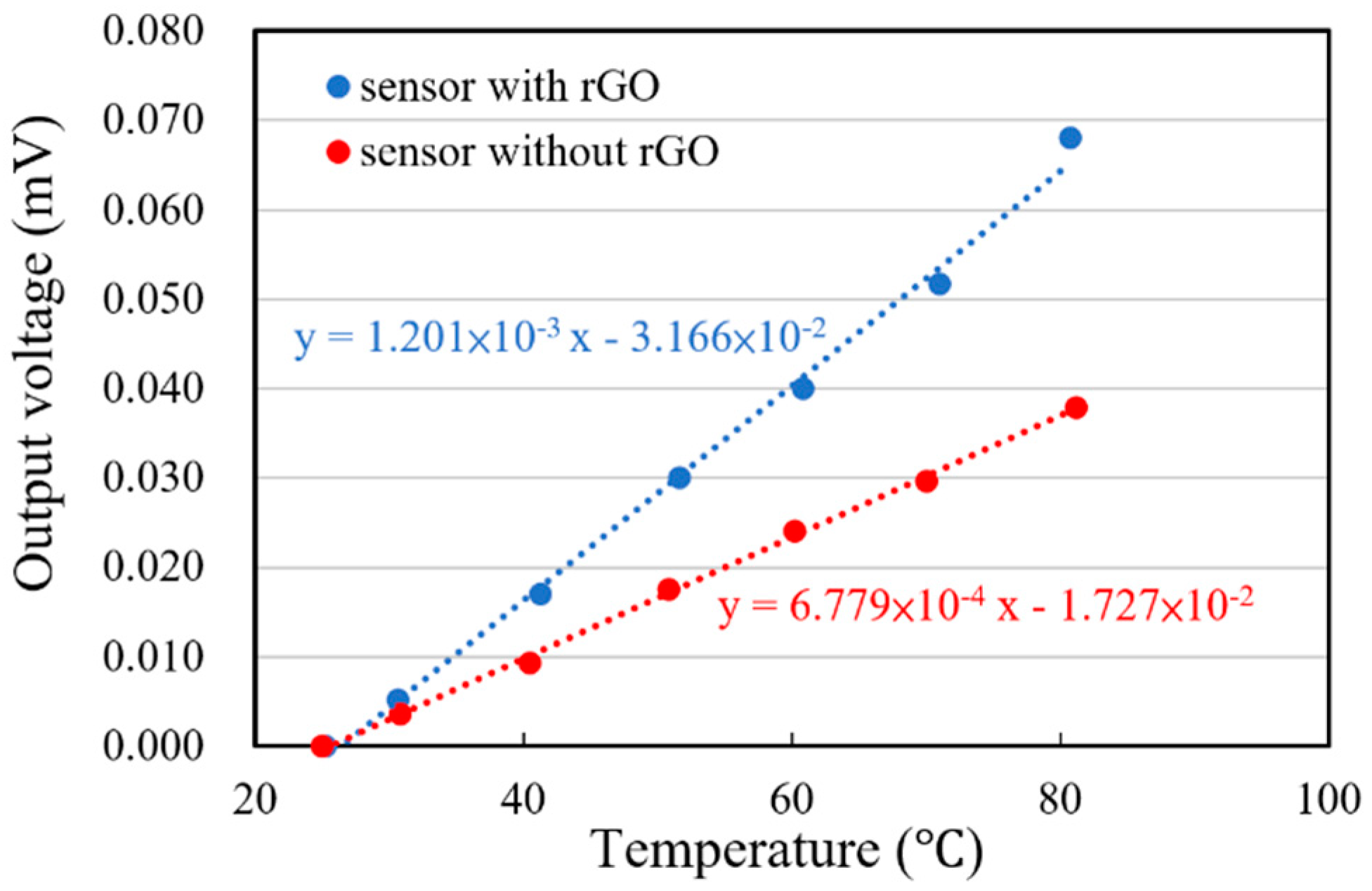
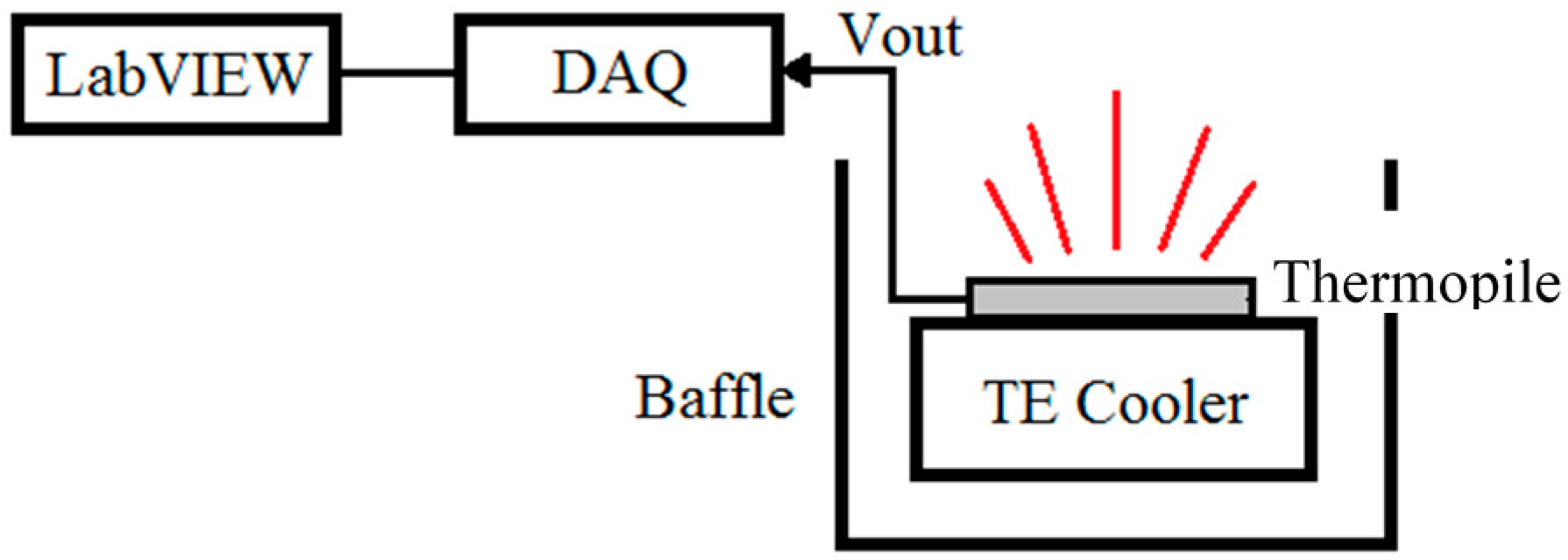

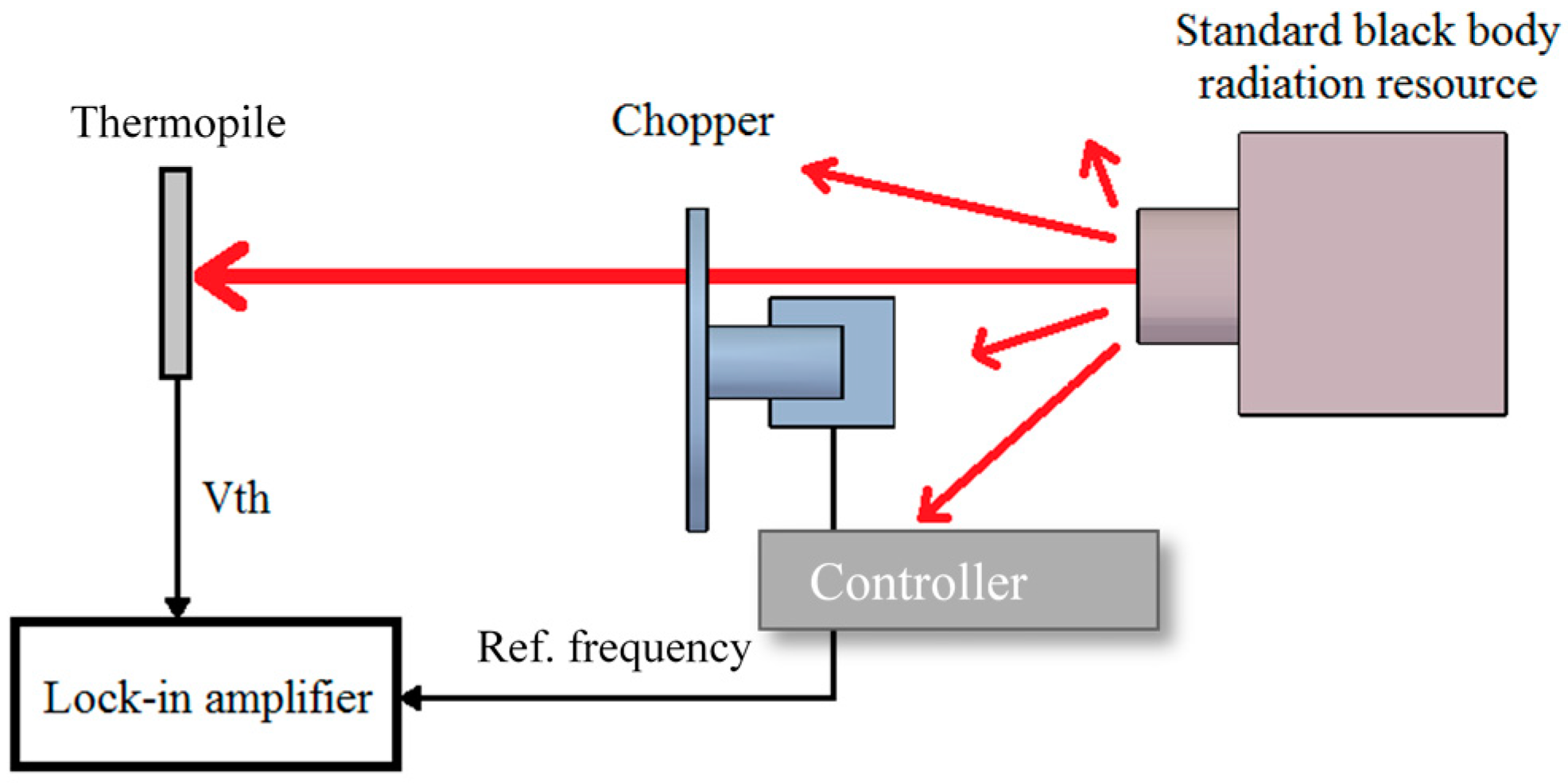
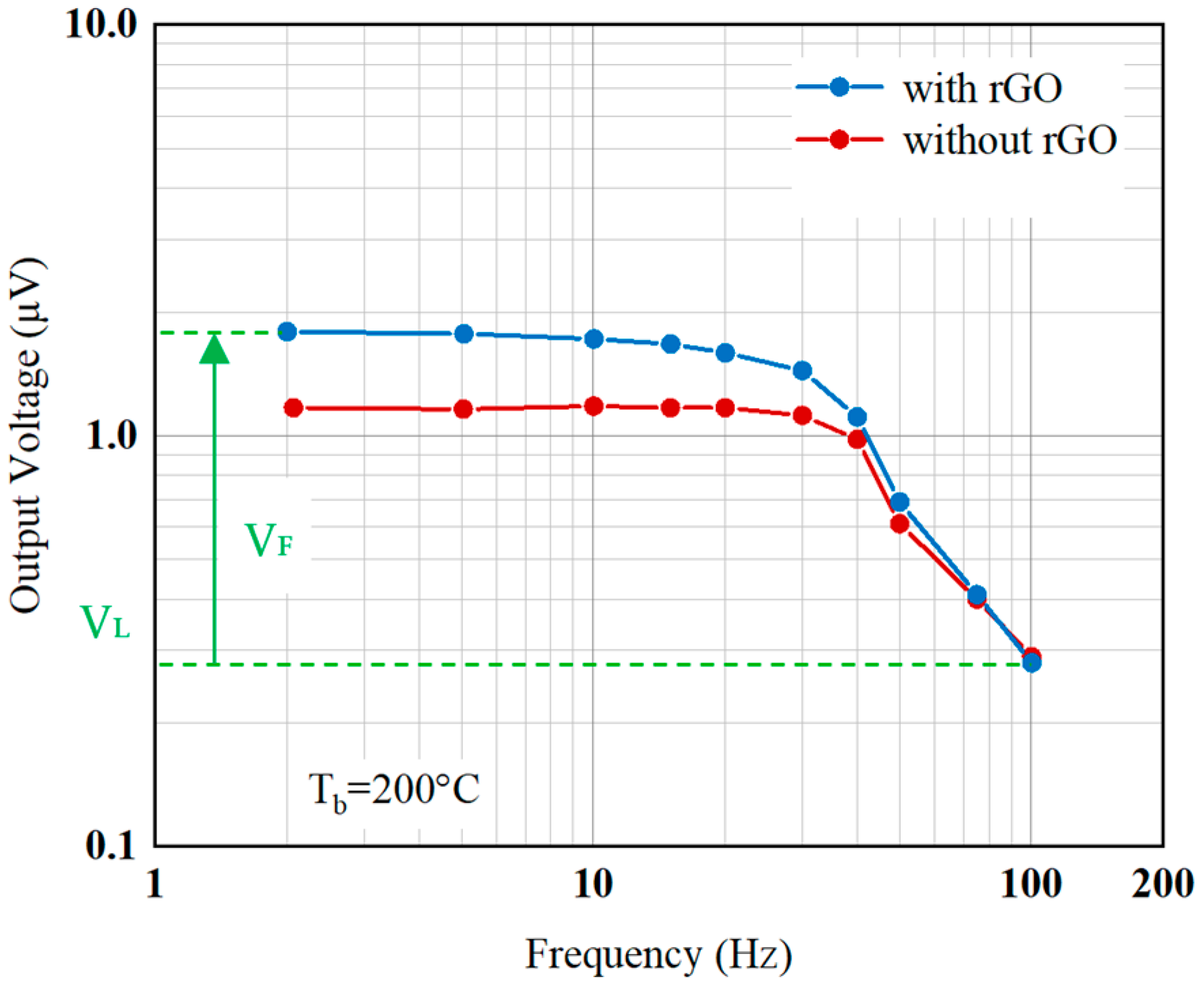


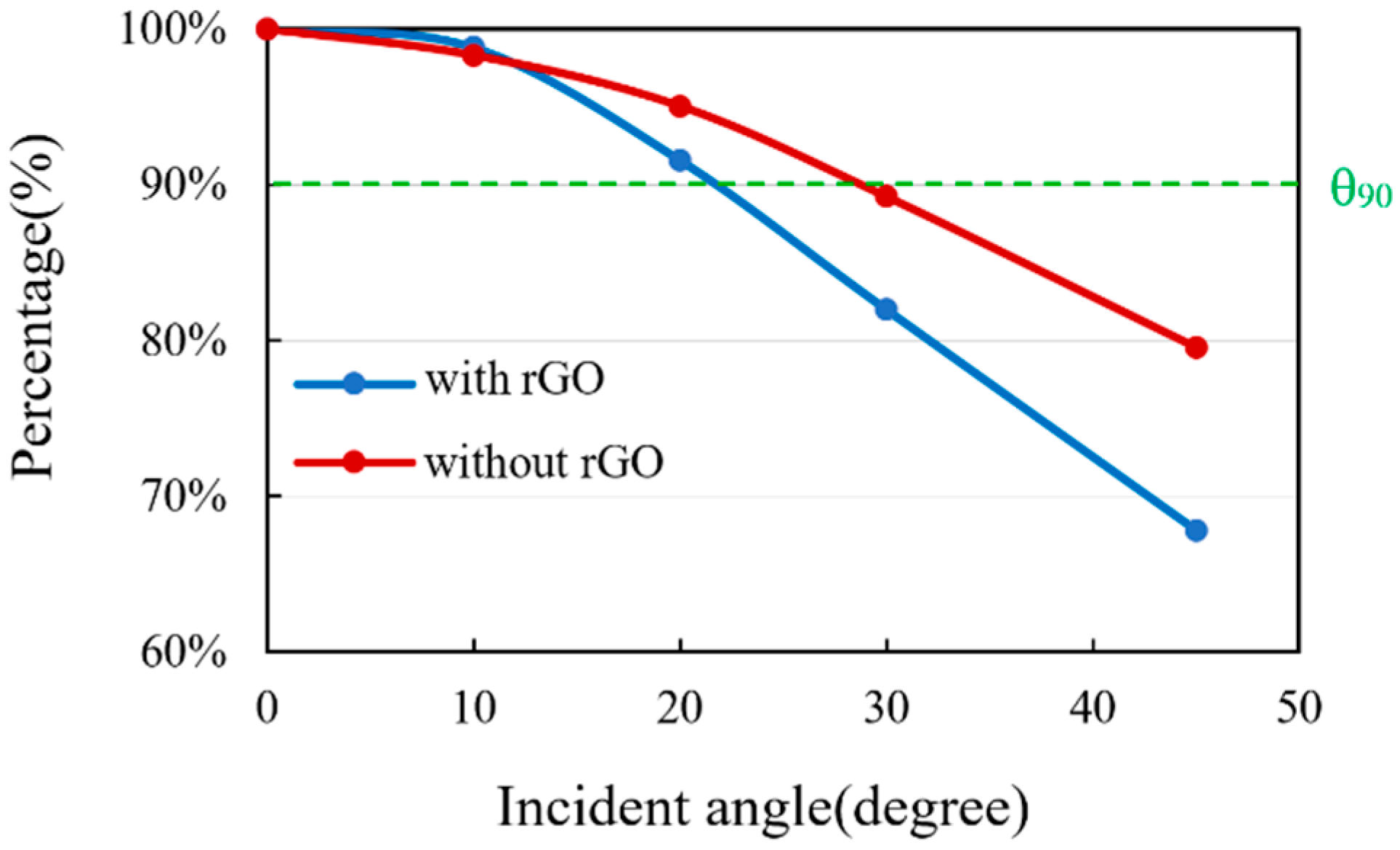
| Parameter (Unit) | with rGO | without rGO |
|---|---|---|
| Responsivity (V/W) | 14.522 | 8.197 |
| Johnson noise (nV/) | 13.716 | 13.716 |
| SNR | 364.43 | 291.54 |
| NEP (W/) | 9.45 × 10−10 | 1.67 × 10−9 |
| Detectivity (nV//W) | 1.06 × 109 | 5.99 × 108 |
| Normalized detectivity (cm·/W) | 1.59 × 107 | 9.02 × 106 |
© 2020 by the authors. Licensee MDPI, Basel, Switzerland. This article is an open access article distributed under the terms and conditions of the Creative Commons Attribution (CC BY) license (http://creativecommons.org/licenses/by/4.0/).
Share and Cite
Chen, S.-J.; Chen, B. Research on a CMOS-MEMS Infrared Sensor with Reduced Graphene Oxide. Sensors 2020, 20, 4007. https://doi.org/10.3390/s20144007
Chen S-J, Chen B. Research on a CMOS-MEMS Infrared Sensor with Reduced Graphene Oxide. Sensors. 2020; 20(14):4007. https://doi.org/10.3390/s20144007
Chicago/Turabian StyleChen, Shu-Jung, and Bin Chen. 2020. "Research on a CMOS-MEMS Infrared Sensor with Reduced Graphene Oxide" Sensors 20, no. 14: 4007. https://doi.org/10.3390/s20144007




